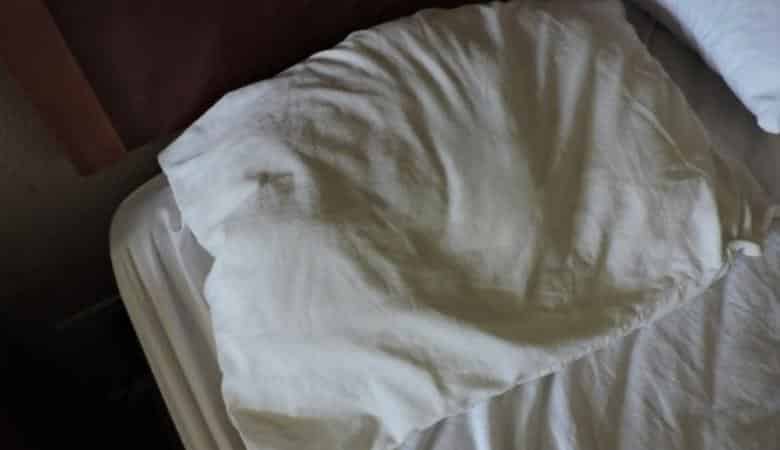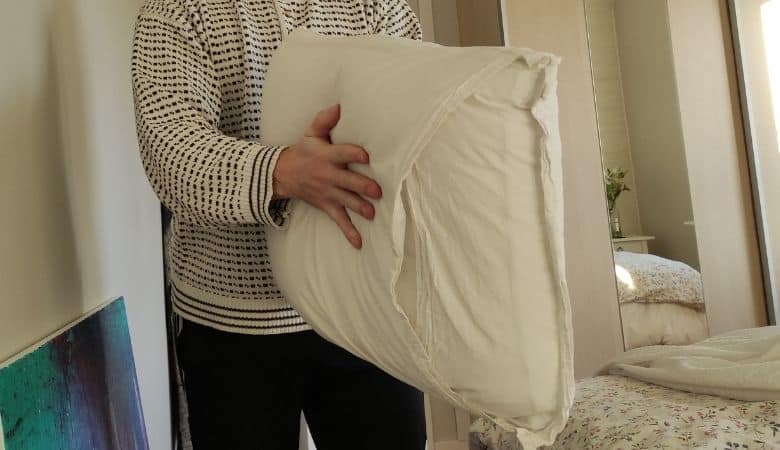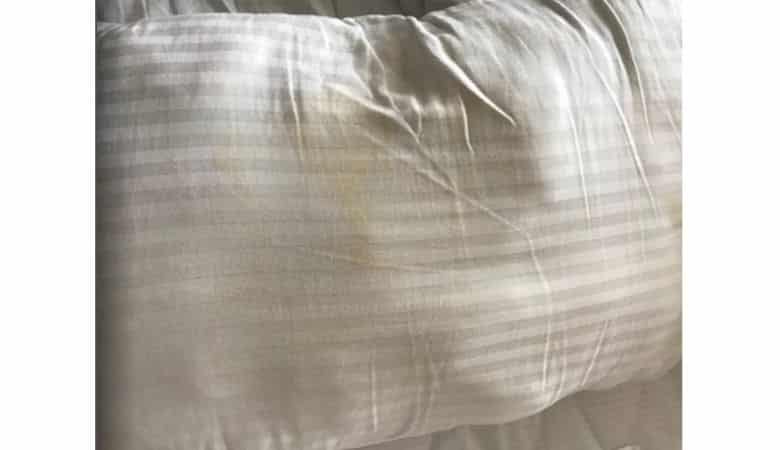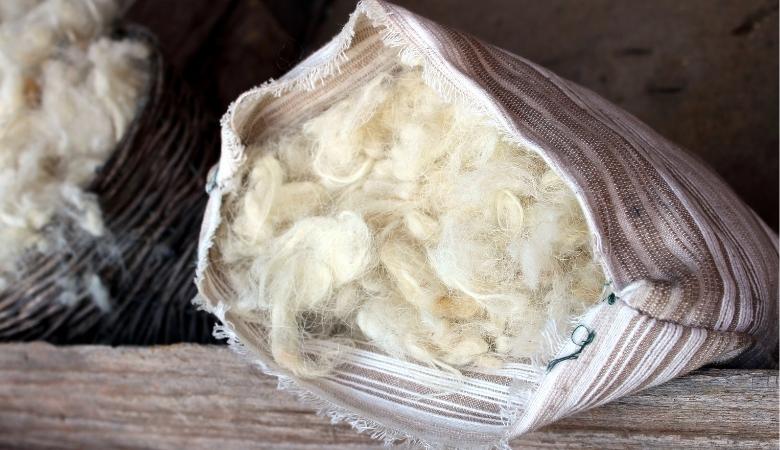This post is a part of the complete wool pillow buyers guide
Wool pillows always look appealing when you first buy them, and you are assured that they will survive beyond their expiry date. However, deterioration is expected for all types of pillows, including wool.
You can stay on the safe side and take care of your pillow to last longer. On the other hand, if you leave your pillow unattended, it might get lumpy.
Wool pillows are softer and can quickly lose their support due to flattening and lumping. There are plenty of benefits to using wool pillows, and that is why they cost a lot.
The soft and fluffy wool pillow can get lumpy and lose its firmness over time. Lucky for you, you can restore the pillow to its original position.
Please keep reading to get some insight into treating your wool pillow to remove lumps and make it more usable.
Why Wool Pillows Get Lumpy?

Organic pillows, including cotton, wool, down, and feather, are subject to deterioration after years of use. You will notice your wool pillow losing its shape, which results in an uncomfortable sleep. The biggest culprit for wool lumping is overuse of the pillow and dirt accumulation.
Wool is an organic material that collects moisture, dead skin, hair, oils, and dust that builds up in the wool filling, causing your wool pillow to lump. Your pillow may also get lumpy because you are using the wrong pillowcase on it.
When you use a more oversized pillowcase than your pillow, the wool shreds will spread out, leaving the pillow flat and shapeless. You will never notice your pillow getting dirty, especially if you do not wash it or maintain it frequently.
When the night is too hot, and your pillow cover has no moisture-wicking or cooling abilities, all the sweat finds its way through your pillow cover into the filling.
When this sweat accumulation is left unattended, they attract dust mites notorious for lumping natural pillow materials. When some spots get clumpy, some get flat, and you will have a hard time getting rid of the dust mites.
Even though washing your pillow might get rid of the dirt, the clumps might still cause discomfort and allergic reactions, hence the need for regular pillow cleaning.
How to Remove Lumps From a Wool Pillow?
Fixing a lumpy pillow is pretty simple and takes a few techniques to achieve. Before doing anything to your pillow, you must be familiar working around wool material.
Removing lumps from your wool pillow starts with getting rid of the dirt or sweat and making your pillow lumpy. This means that you need to wash your pillow either in the washing machine or by hand.
However, wool is quite delicate to handle, so you should wash it and dry it in a machine.
1. Fluff the pillow every morning

If fluffing your pillow is not part of your routine, it is time you start doing it before you bid your pillow goodbye. Fluffing your pillow every morning can help you undo lumps or prevent your pillow from further lumping. Bat it with your hands repeatedly until the entire surface regains its original shape.
You can place the pillow on your bed, grab it on both corners and suddenly pick your pillow up and shake it. Repeat this process for the longer side of the pillow and beat it with your hands until you feel that the lumps have broken down.
This technique achieves unclamping by restoring airflow within the fillings, improving malleability and shape all through. If you do this every day, your pillow will not lump, and it will last longer.
2. Machine dry your pillow
If you have a dryer in your house, you can use it to unclamp your pillow. Many people may not know about this technique, but it works like magic. All you have to do is enclose your pillow with a clean towel or any thick fabric and toss them in the drier for about 15 minutes on high heat.
This process redistributes any lumps covering the entire pillow fillings. You can use your pillow immediately after removing the lumps without stressing about feeling them on your neck while sleeping.
To effectively dry the pillow, place two or three tennis balls in the dryer alongside your pillows. The balls will bounce on your pillow, fluffing it further to regain its original shape. If you have larger lumps, you will have to try other unclamping techniques.
3. Hit the lumps with a tennis ball
Still, you can use the tennis ball technique to make a hammer-like re-fluffing tool. Place the wool pillow on a flat surface and hit it with a hammer—targeting all the hard lumps. The hammering force should facilitate the redistribution of fillers to their positions.
These ensure that you sleep on an evenly distributed wool pillow.
4. Wash Your Wool Pillow Correctly to Avoid Lumping

Wool pillows are sensitive to moisture, and you need to be careful when washing them. Check instructions on how your pillow needs to be washed and follow them to the letter. If your pillow is machine washable, follow these steps.
Step 1
When washing wool pillows, use warm water on a gentle cycle to prevent further lumping.
While doing this, avoid using conditioners because they are very notorious for ruining your filling. If you are using a top-loading machine with an agitator, you need to place two pillows adjacent to each other to balance the load. You can also add laundry if the load is not well-balanced.
When washing the pillow in a front-loading machine, you will place your pillow with the laundry to provide support and prevent it from bouncing and further lumping the pillow.
Step 2
Once the washing cycle is complete, run the pillow on a second cycle to rinse it. This ensures that all soap and detergent residue is eradicated to prevent bad odors.
Step 3
Place your pillows in a drying machine and use the necessary tools for beating away the lumps. The pillows should be on low heat to prevent your wool fillings from having burn smells. If the lumps are still there, try this next step.
5. Massage The Pillow
Sometimes your hands work better in eradicating lumps on your pillow. You first have to squeeze the pillow in your hands to identify areas with lumps. Your fingers should gently massage the external pillow fabric to break down the lumps. Repeat this method until there are no other lumps left.
After the process is complete, fluff the pillow again and place it on your bed to get some sleep.
6. Air dry your pillows
If you are not willing to buy a new pillow, there are many ways to solve the lump issue on your current one. You should try as much as possible to air dry your pillow after washing or after a week to enhance aeration and break down the lumps.
Keep re-fluffing your pillows throughout the day to improve the airflow.
7. Remove wool stuffing from the pillow

Some stubborn lumps will need to be removed by removing the stuffing from your pillow. Removing stuffing ensures that fillers are evenly redistributed within the pillow. First, you need to push your fingers in the corner and pull them with both hands to remove the excess stuff.
Most wool pillows have a zipper on the cover, which simplifies filling removal. You can take out all the fillings and pick out the lumps by hand. Place them on the side, and place back the undamaged fillings into the pillow. Discard the bad filling and replace it with new ones if the manufacturer separately sells wool.
If you are good at stitching, unstitch the one side of the pillow edge to remove wool filling. Once everything looks fine, stitch the pillow back together and place it on your bed.
What to do if The Pillow Can’t be Fixed?
Your pillow must have gone through a lot before completely getting lumpy beyond salvation. You sleep on your pillow for hundreds of hours within a month.
If you have tried re-fluffing your pillow and it does not seem to work, maybe you should replace your pillow.
Indicators That You Should Replace Your Pillow
1. It has an odor
After unclamping your pillow and it still has some foul smell, you need to get a new one. This shows that the sweat and dust build-up is out of hand, and no amount of cleaning can restore the pillow back to normal.
2. The lumps are noticeable

The unclamping techniques can help your pillow become flat and supportive. However, some pillows lump beyond restoration, and these lumps are noticeable from a distance.
This means that the pillow will not comfortably support you, so you need to get a new one.
3. You are developing acne
Oil, dust mites, moisture, and dead skin cells can cause breakouts on your face. While you can wash your pillow to make it more useful and fresh, notorious lumps may never shed off all harmful bacteria and particles. You may develop acne or notice that your acne is becoming worse. If this happens, forget about the pillow and get a new wool pillow.
4. It can easily fold
Lumping causes your pillow to become flat and soft. It is normal for people to fold their pillows when they sleep. If you do this regularly, you expect them to regain their initial shape after waking up. A completely ruined pillow may fold and never revert to its original shape. The center remains flat while the edges have excess lumped stuff if it does.
If you fold your pillow into two and it does not go back into position, you should go shopping for a new wool pillow.
5. You always wake up sneezing
Dust mites love lumped pillows more than anything else. A lumped pillow has a lot of dust mites that will not go away even after plenty of washing. These dust mites can make you sneeze a lot throughout the night, and if you are allergic, you could have to deal with many nights of discomfort.
To prevent developing severe allergies, buy a new pillow instead of removing lumps from the old pillow.
6. Frequent neck and shoulder pain

While some people wake up refreshed and energized in the morning, some wake up with neck and shoulder pain. If you are one of those suffering the effects of a lumped pillow, you should get frequent massages and a new pillow.
7. It is severely stained
Lumped pillows carry more dirt than regular pillows. These dirt stains are even visible on the pillowcase. If you look at your pillow and see stains on it, you can try spot cleaning to remove the stains. However, if spot cleaning does not work for you, it means that you need a replacement.
Stains on your pillow not only look gross, but they can harbor bacteria that will make you sick. When the exterior is severely stained, imagine the insides. This is enough to tell you that you need a new pillow.
8. You cannot sleep comfortably at night
A lumpy pillow is uncomfortable to sleep on, and you will keep changing your sleeping position every day. If you are no longer sleeping in your common sleeping position, your pillow may use a replacement. Wool pillows work for any sleeping position, and if they get flat or lose their shape, they may not work best for you.
You can change your sleeping position as many times as possible, but if the pillow is still lumpy and uncomfortable, do yourself a favor and get a new one.
9. You constantly try to “unlump” your pillow
Sometimes fluffing your pillow more than once in a month means that your pillow is past its glory days. This means that you are trying to revive a pillow doing you no good. The pillow will also not support you as you intended it to.
Get a new pillow and sleep comfortably without worrying about discomfort to save your precious time and energy.
How to Get The Most Out of Your Wool Pillow

Natural wool is very sensitive, and you need to take proper care of it. This ensures that you maintain the unique properties of the pillow.
1. Use a pillowcase
A pillowcase can do more than keep your pillow clean. A pillowcase prevents moisture entry into the wool fibers, thus preventing further lumping. The right pillow size will also ensure that the wool filling does not extend into the other corners of the pillow.
When buying a pillowcase, ensure that you know the accurate size of the pillow for a perfect fit.
2. Wash your pillow as required
Every pillow manufacturer issues instructions about how their products should be washed. Always read the instructions sticker before throwing the pillow into the washing machine or dryer. Here are a few points to note when washing the pillow.
- Avoid washing the pillow on a standard cycle with other loads. When you wash the pillow on a normal cycle, the wool filling shrinks and mats together to develop a smooth texture.
- Use warm water to kill the bacteria and maintain the pillow’s loft on a gentle cycle.
- Use a bigger washing machine that can handle over 60 pounds of load. The extra load space facilitates the smooth flow of water to prevent the wool from lumping.
- If the pillow is not lumped, spot cleaning is the best way to clean the stains. Spot cleaning is a non-invasive cleaning method that works best for all types of pillows.
3. Dry your pillow as required
Follow these guidelines when drying your pillow.
- Use a large dryer to remove excess moisture from your wool pillow. Set the temperature at low and avoid using a small or hot dryer that would damage the wool material.
- Be keen on the pillows tumbling to prevent them from being stuck in one position either due to their sizes or obstructed movement by other objects. Air drying should not hit the same spot on the pillow.
- Only dry one pillow at a time and never operate mixed loads. If you have to fluff, run it on a separate cycle.
Wool Pillows: A Complete Buyers Guide – Parts:
1. Why Use a Wool Pillow? The Benefits & Drawbacks
2. Wool vs. Down Pillows: Similarities, Differences & Which to Choose
3. How Long Do Wool Pillows Last? This is The Replacement Time
4. Do Wool Pillows Sleep Hot or Cool? Or Both Depending on The Climate?
5. Why do Wool Pillows Get Lumpy? How to “Unlump” Them
6. How to Soften a Wool Pillow: Step by Step Guide
7. How to Wash And Dry a Wool Pillow: Step by Step Guide
8. Best Wool Pillows of 2022 – Complete Review
